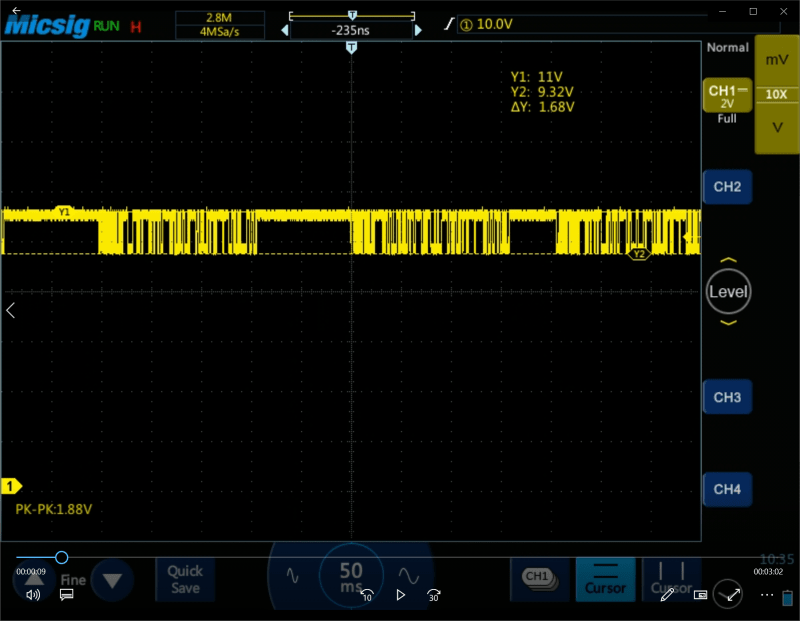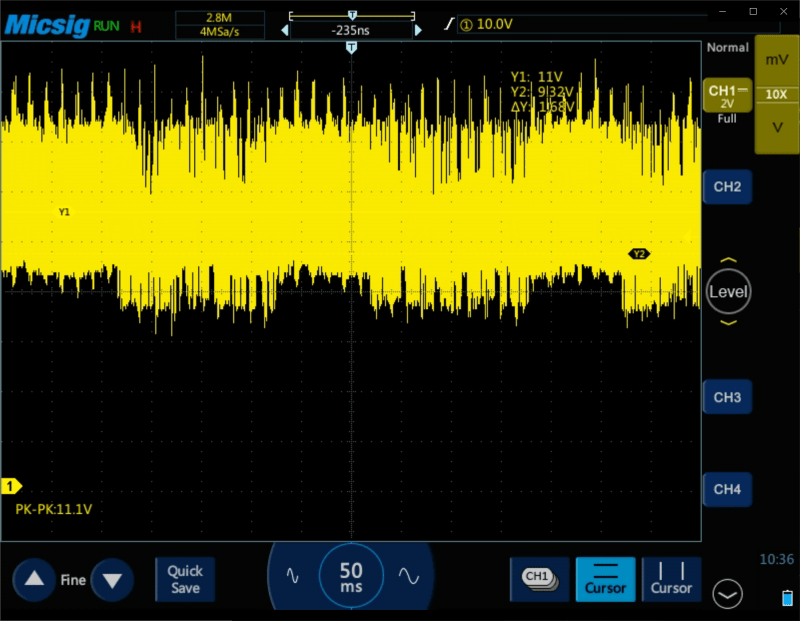davemcl
Electrical
- Jul 19, 2020
- 9
We have a custom built data logger with 4-20mA inputs that when tested with a current loop calibrator, the input is stable to 2 decimal places with the 3rd decimal fluctuating around +-0.003mA. The input has a 100 ohm resistor from the ADC input to ground. The ADC is a very stable 16 bit with the above readings.
The VSD is a 75KW Altivar model.
We have a client supplied sensor connected, Wisner WPT-80G-A7N2, 40 bar gauge, stated accuracy 0.5%, and with atmospheric pressure applied, fluctuates around -2 to 3 PSI with the VSD not running. The attached image shows the VSD stopped and then started and the increase on the sensor noise. I am waiting for a sensor to arrived to do some testing here in our workshop.
The client has connected the EARTH pin on the sensor to the VSD ground in the cabinet. Without this ground connection, the 4-20mA signal is sitting around 1.6mA ??? With it connected, the signal fluctuates around the 4mA point.
Sadly they have used 3 core flexible rubber cable of some 150 meters long and I suspect this has a lot to do with the issue.
We saw this issue of noise from the VSD in early testing at the clients workshop with our downhole gauge but we were able to fix this by connecting the gauge ground point directly to the VSD ground in the cabinet. There was a large ground loop between the VSD motor earthing and the gauge ground. As the 4-20mA sensor is isolated we cannot connect this to ground in the same manner.
The DC supply for the data logger has no internal connection from the OV output and the EARTH pin so the DC 0V for the logger is isolated from the VSD ground. We have a connection from this 0V to he VSD ground. Would isolating this be worth testing?
The VSD is a 75KW Altivar model.
We have a client supplied sensor connected, Wisner WPT-80G-A7N2, 40 bar gauge, stated accuracy 0.5%, and with atmospheric pressure applied, fluctuates around -2 to 3 PSI with the VSD not running. The attached image shows the VSD stopped and then started and the increase on the sensor noise. I am waiting for a sensor to arrived to do some testing here in our workshop.
The client has connected the EARTH pin on the sensor to the VSD ground in the cabinet. Without this ground connection, the 4-20mA signal is sitting around 1.6mA ??? With it connected, the signal fluctuates around the 4mA point.
Sadly they have used 3 core flexible rubber cable of some 150 meters long and I suspect this has a lot to do with the issue.
We saw this issue of noise from the VSD in early testing at the clients workshop with our downhole gauge but we were able to fix this by connecting the gauge ground point directly to the VSD ground in the cabinet. There was a large ground loop between the VSD motor earthing and the gauge ground. As the 4-20mA sensor is isolated we cannot connect this to ground in the same manner.
The DC supply for the data logger has no internal connection from the OV output and the EARTH pin so the DC 0V for the logger is isolated from the VSD ground. We have a connection from this 0V to he VSD ground. Would isolating this be worth testing?


